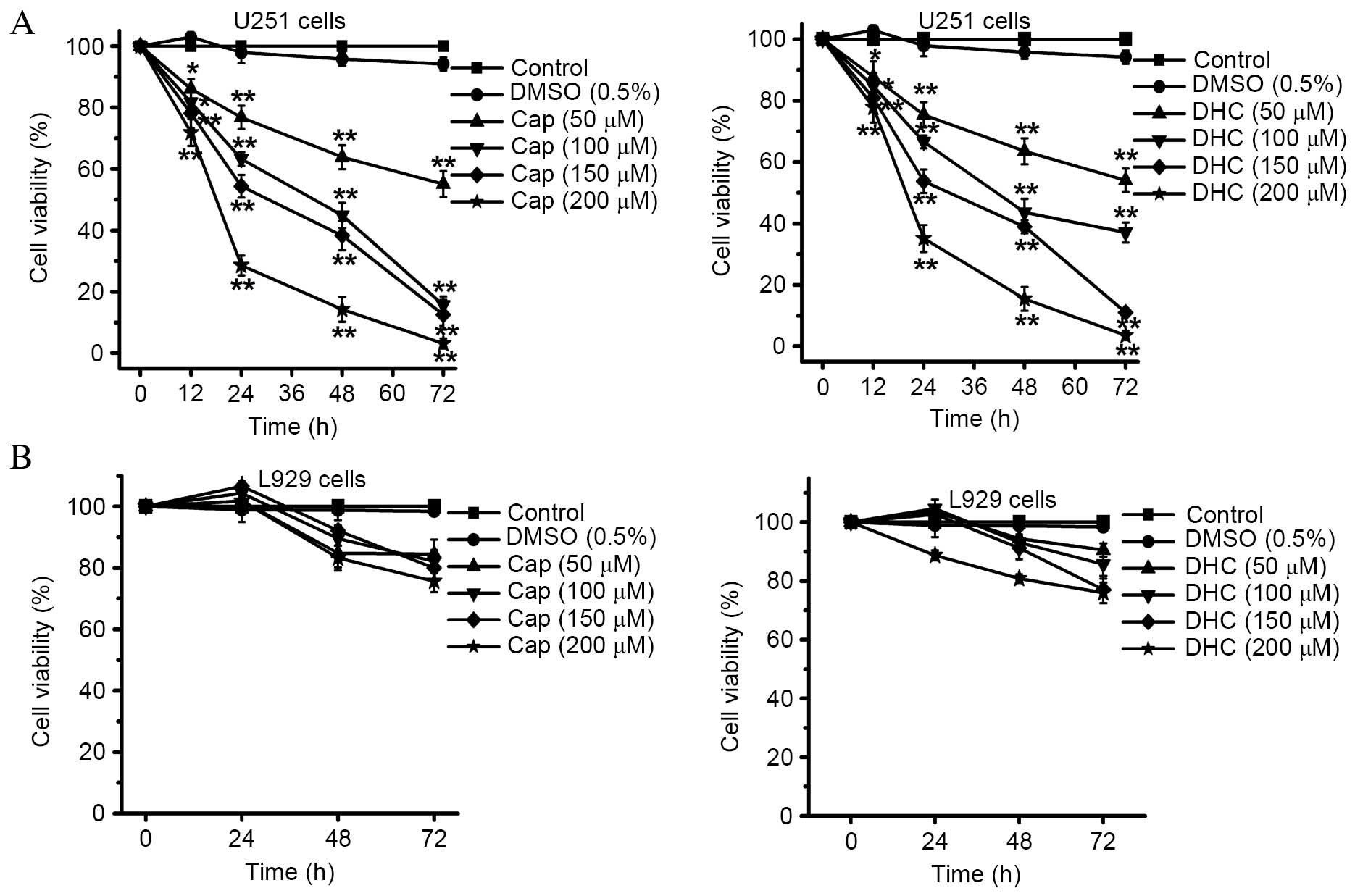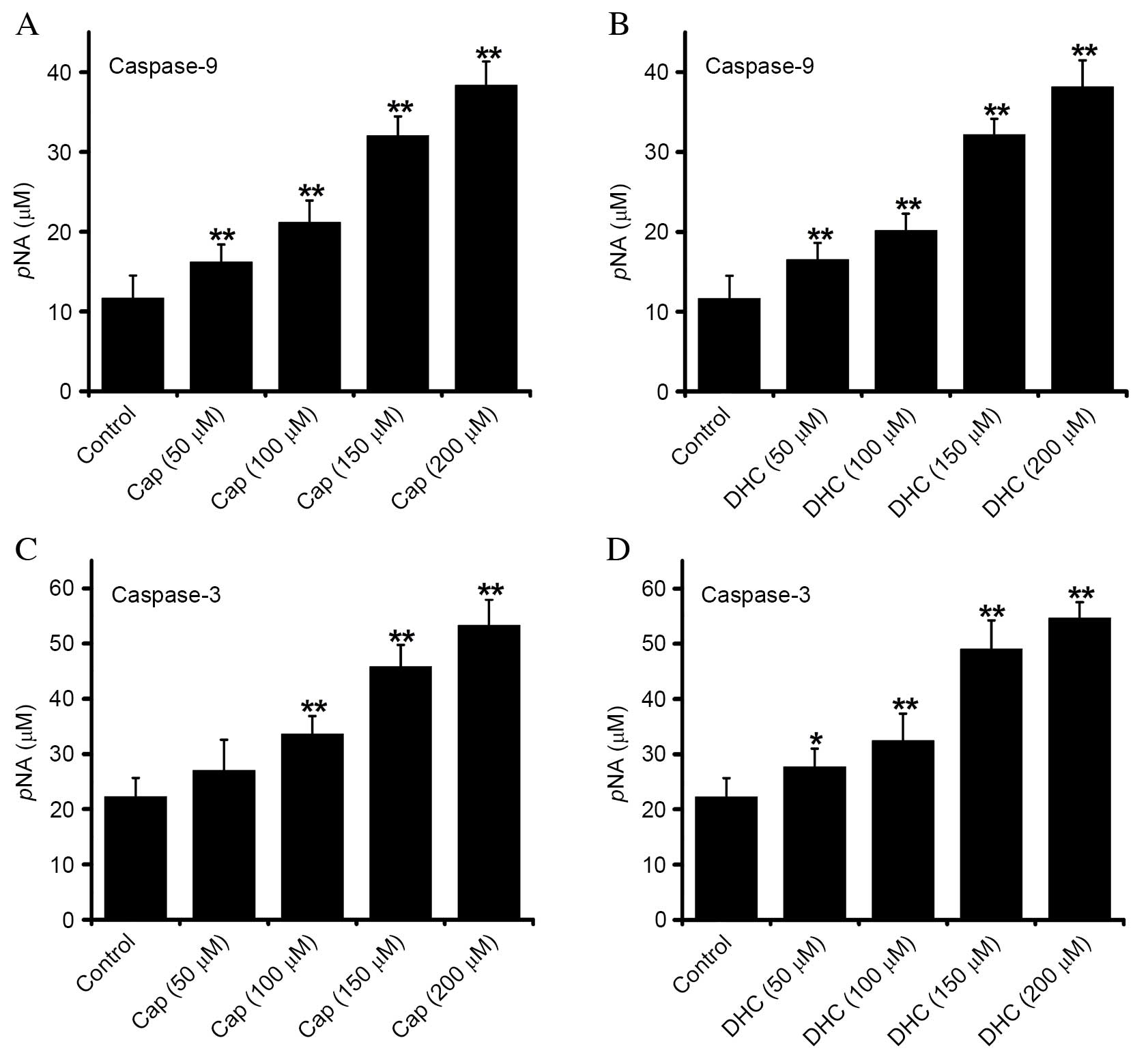|
1
|
Brem SS, Bierman PJ, Brem H, Butowski N,
Chamberlain MC, Chiocca EA, DeAngelis LM, Fenstermaker RA, Friedman
A, Gilbert MR, et al: Central nervous system cancers. J Natl Compr
Canc Netw. 9:352–400. 2011.PubMed/NCBI
|
|
2
|
Wen PY and Kesari S: Malignant gliomas in
adults. N Engl J Med. 359:492–507. 2008. View Article : Google Scholar : PubMed/NCBI
|
|
3
|
Maher EA, Furnari FB, Bachoo RM, Rowitch
DH, Louis DN, Cavenee WK and DePinho RA: Malignant glioma: Genetics
and biology of a grave matter. Genes Dev. 15:1311–1333. 2001.
View Article : Google Scholar : PubMed/NCBI
|
|
4
|
Malagarie-Cazenave S, Olea-Herrero N, Vara
D, Morell C and Diaz-Laviada I: The vanilloid capsaicin induces
IL-6 secretion in prostate PC-3 cancer cells. Cytokine. 54:330–337.
2011. View Article : Google Scholar : PubMed/NCBI
|
|
5
|
Deb G, Thakur VS, Limaye AM and Gupta S:
Epigenetic induction of tissue inhibitor of matrix
metalloproteinase-3 by green tea polyphenols in breast cancer
cells. Mol Carcinog. 54:485–499. 2015. View
Article : Google Scholar : PubMed/NCBI
|
|
6
|
Feng LL, Liu BX, Zhong JY, Sun LB and Yu
HS: Effect of grape procyanidins on tumor angiogenesis in liver
cancer xenograft models. Asian Pac J Cancer Prev. 15:737–741. 2014.
View Article : Google Scholar : PubMed/NCBI
|
|
7
|
Zhang X, Zhu Y, Duan W, Feng C and He X:
Allicin induces apoptosis of the MGC-803 human gastric carcinoma
cell line through the p38 mitogen-activated protein
kinase/caspase-3 signaling pathway. Mol Med Rep. 11:2755–2760.
2015.PubMed/NCBI
|
|
8
|
Luo XJ, Peng J and Li YJ: Recent advances
in the study on capsaicinoids and capsinoids. Eur J Pharmacol.
650:1–7. 2011. View Article : Google Scholar : PubMed/NCBI
|
|
9
|
Brown KC, Witte TR, Hardman WE, Luo H,
Chen YC, Carpenter AB, Lau JK and Dasgupta P: Capsaicin displays
anti-proliferative activity against human small cell lung cancer in
cell culture and nude mice models via the E2F pathway. PLoS One.
5:e102432010. View Article : Google Scholar : PubMed/NCBI
|
|
10
|
Sánchez AM, Martínez-Botas J,
Malagarie-Cazenave S, Olea N, Vara D, Lasunción MA and Díaz-Laviada
I: Induction of the endoplasmic reticulum stress protein
GADD153/CHOP by capsaicin in prostate PC-3 cells: A microarray
study. Biochem Biophys Res Commun. 372:785–791. 2008. View Article : Google Scholar : PubMed/NCBI
|
|
11
|
Zhang R, Humphreys I, Sahu RP, Shi Y and
Srivastava SK: In vitro and in vivo induction of apoptosis by
capsaicin in pancreatic cancer cells is mediated through ROS
generation and mitochondrial death pathway. Apoptosis.
13:1465–1478. 2008. View Article : Google Scholar : PubMed/NCBI
|
|
12
|
Chang HC, Chen ST, Chien SY, Kuo SJ, Tsai
HT and Chen DR: Capsaicin may induce breast cancer cell death
through apoptosis-inducing factor involving mitochondrial
dysfunction. Hum Exp Toxicol. 30:1657–1665. 2011. View Article : Google Scholar : PubMed/NCBI
|
|
13
|
Ip SW, Lan SH, Lu HF, Huang AC, Yang JS,
Lin JP, Huang HY, Lien JC, Ho CC, Chiu CF, et al: Capsaicin
mediates apoptosis in human nasopharyngeal carcinoma NPC-TW 039
cells through mitochondrial depolarization and endoplasmic
reticulum stress. Hum Exp Toxicol. 31:539–549. 2012. View Article : Google Scholar : PubMed/NCBI
|
|
14
|
Thoennissen NH, O'Kelly J, Lu D, Iwanski
GB, La DT, Abbassi S, Leiter A, Karlan B, Mehta R and Koeffler HP:
Capsaicin causes cell-cycle arrest and apoptosis in ER-positive and
-negative breast cancer cells by modulating the EGFR/HER-2 pathway.
Oncogene. 29:285–296. 2010. View Article : Google Scholar : PubMed/NCBI
|
|
15
|
Ip SW, Lan SH, Huang AC, Yang JS, Chen YY,
Huang HY, Lin ZP, Hsu YM, Yang MD, Chiu CF and Chung JG: Capsaicin
induces apoptosis in SCC-4 human tongue cancer cells through
mitochondria-dependent and -independent pathways. Environ Toxicol.
27:332–341. 2012. View Article : Google Scholar : PubMed/NCBI
|
|
16
|
Bley K, Boorman G, Mohammad B, McKenzie D
and Babbar S: A comprehensive review of the carcinogenic and
anticarcinogenic potential of capsaicin. Toxicol Pathol.
40:847–873. 2012. View Article : Google Scholar : PubMed/NCBI
|
|
17
|
Amantini C, Ballarini P, Caprodossi S,
Nabissi M, Morelli MB, Lucciarini R, Cardarelli MA, Mammana G and
Santoni G: Triggering of transient receptor potential vanilloid
type 1 (TRPV1) by capsaicin induces Fas/CD95-mediated apoptosis of
urothelial cancer cells in an ATM-dependent manner. Carcinogenesis.
30:1320–1329. 2009. View Article : Google Scholar : PubMed/NCBI
|
|
18
|
Gil YG and Kang MK: Capsaicin induces
apoptosis and terminal differentiation in human glioma A172 cells.
Life Sci. 82:997–1003. 2008. View Article : Google Scholar : PubMed/NCBI
|
|
19
|
Maity R, Sharma J and Jana NR: Capsaicin
induces apoptosis through ubiquitin-proteasome system dysfunction.
J Cell Biochem. 109:933–942. 2010.PubMed/NCBI
|
|
20
|
Oh SH, Kim YS, Lim SC, Hou YF, Changl IY
and You HJ: Dihydrocapsaicin (DHC), a saturated structural analog
of capsaicin, induces autophagy in human cancer cells in a
catalase-regulated manner. Autophagy. 4:1009–1019. 2008. View Article : Google Scholar : PubMed/NCBI
|
|
21
|
Choi CH, Jung YK and Oh SH: Selective
induction of catalase-mediated autophagy by dihydrocapsaicin in
lung cell lines. Free Radic Biol Med. 49:245–257. 2010. View Article : Google Scholar : PubMed/NCBI
|
|
22
|
Fallone CA, Loo VG, Lough J and Barkun AN:
Hematoxylin and eosin staining of gastric tissue for the detection
of helicobacter pylori. Helicobacter. 2:32–35. 1997. View Article : Google Scholar : PubMed/NCBI
|
|
23
|
Cook SA, Sugden PH and Clerk A: Regulation
of bcl-2 family proteins during development and in response to
oxidative stress in cardiac myocytes: Association with changes in
mitochondrial membrane potential. Circ Res. 85:940–949. 1999.
View Article : Google Scholar : PubMed/NCBI
|
|
24
|
Halestrap AP: What is the mitochondrial
permeability transition pore? J Mol Cell Cardiol. 46:821–831. 2009.
View Article : Google Scholar : PubMed/NCBI
|
|
25
|
Kinnallyk W, Peixotop M, Ryu SY and Dejean
LM: Is mPTP the gatekeeper for necrosis, apoptosis, or both?
Biochim Biophys Acta. 1813:616–622. 2011. View Article : Google Scholar : PubMed/NCBI
|
|
26
|
Hoek JB, Cahill A and Pastorino JG:
Alcohol and mitochondria: A dysfunctional relationship.
Gastroenterology. 122:2049–2063. 2002. View Article : Google Scholar : PubMed/NCBI
|
|
27
|
Wagner L, Marschall V, Karl S, Cristofanon
S, Zobel K, Deshayes K, Vucic D, Debatin KM and Fulda S: Smac
mimetic sensitizes glioblastoma cells to Temozolomide-induced
apoptosis in a RIP1- and NF-κB-dependent manner. Oncogene.
32:988–997. 2013. View Article : Google Scholar : PubMed/NCBI
|
|
28
|
Eriksson I, Joosten M, Roberg K and
Ollinger K: The histone deacetylase inhibitor trichostatin A
reduces lysosomal pH and enhances cisplatin-induced apoptosis. Exp
Cell Res. 319:12–20. 2013. View Article : Google Scholar : PubMed/NCBI
|
|
29
|
Indran IR, Tufo G, Pervaiz S and Brenner
C: Recent advances in apoptosis, mitochondria and drug resistance
in cancer cells. Biochim Biophys Acta. 1807:735–745. 2011.
View Article : Google Scholar : PubMed/NCBI
|
|
30
|
Patwardhan CA, Alfa E, Lu S and Chadli A:
Progesterone receptor chaperone complex-based high-throughput
screening assay: Identification of capsaicin as an inhibitor of the
Hsp90 machine. J Biomol Screen. 20:223–229. 2015. View Article : Google Scholar : PubMed/NCBI
|
|
31
|
Lewinska A, Jarosz P, Czech J, Rzeszutek
I, Bielak-Zmijewska A, Grabowska W and Wnuk M: Capsaicin-induced
genotoxic stress does not promote apoptosis in A549 human lung and
DU145 prostate cancer cells. Mutat Res Genet Toxicol Environ
Mutagen. 779:23–34. 2015. View Article : Google Scholar : PubMed/NCBI
|
|
32
|
Williams GH and Stoeber K: The cell cycle
and cancer. J Pathol. 226:352–364. 2012. View Article : Google Scholar : PubMed/NCBI
|
|
33
|
Wu CC, Lin JP, Yang JS, Chou ST, Chen SC,
Lin YT, Lin HL and Chung JG: Capsaicin induced cell cycle arrest
and apoptosis in human esophagus epidermoid carcinoma CE 81T/VGH
cells through the elevation of intracellular reactive oxygen
species and Ca2+ productions and caspase-3 activation. Mutat Res.
601:71–82. 2006. View Article : Google Scholar : PubMed/NCBI
|
|
34
|
Tsou MF, Lu HF, Chen SC, Wu LT, Chen YS,
Kuo HM, Lin SS and Chung JG: Involvement of Bax, Bcl-2, Ca2+ and
caspase-3 in capsaicin-induced apoptosis of human leukemia HL-60
cells. Anticancer Res. 26:1965–1971. 2006.PubMed/NCBI
|
|
35
|
Ito K, Nakazato T, Yamato K, Miyakawa Y,
Yamada T, Hozumi N, Segawa K, Ikeda Y and Kizaki M: Induction of
apoptosis in leukemic cells by homovanillic acid derivative,
capsaicin, through oxidative stress: Implication of phosphorylation
of p53 at Ser-15 residue by reactive oxygen species. Cancer Res.
64:1071–1078. 2004. View Article : Google Scholar : PubMed/NCBI
|
|
36
|
Abdel-Salam Omar ME: Capsaicin as a
Therapeutic Molecule. Springer; Basel: pp. 181–203. 2014
|
|
37
|
Pramanik KC, Boreddy SR and Srivastava SK:
Role of mitochondrial electron transport chain complexes in
capsaicin mediated oxidative stress leading to apoptosis in
pancreatic cancer cells. PLoS One. 6:e201512011. View Article : Google Scholar : PubMed/NCBI
|
|
38
|
Kinnally KW, Peixoto PM, Ryu SY and Dejean
LM: Is mPTP the gatekeeper for necrosis, apoptosis, or both?
Biochim Biophys Acta. 1813:616–622. 2011. View Article : Google Scholar : PubMed/NCBI
|
|
39
|
Jeong SY and Seol DW: The role of
mitochondria in apoptosis. BMB Rep. 41:11–22. 2008. View Article : Google Scholar : PubMed/NCBI
|
|
40
|
Brunelle JK and Zhang B: Apoptosis assays
for quantifying the bioactivity of anticancer drug products. Drug
Resist Updat. 13:172–179. 2010. View Article : Google Scholar : PubMed/NCBI
|
|
41
|
O'Neill J, Brock C, Olesen AE, Andresen T,
Nilsson M and Dickenson AH: Unravelling the mystery of capsaicin: A
tool to understand and treat pain. Pharmacol Rev. 64:939–971. 2012.
View Article : Google Scholar : PubMed/NCBI
|
|
42
|
Al Othman ZA, Ahmed YB, Habila MA and
Ghafar AA: Determination of capsaicin and dihydrocapsaicin in
capsicum fruit samples using high performance liquid
chromatography. Molecules. 16:8919–8929. 2011. View Article : Google Scholar : PubMed/NCBI
|
|
43
|
Capsaicin as a Therapeutic Molecule. In:
Capsaicin as a Therapeutic Molecule. 68. AbdelSalam OME: Springer
Basel Ag; Picassoplatz 4, Basel, 4052, Switzerland: 2014,
View Article : Google Scholar
|
















